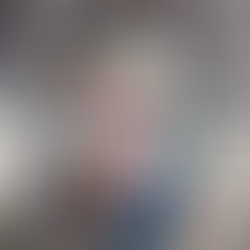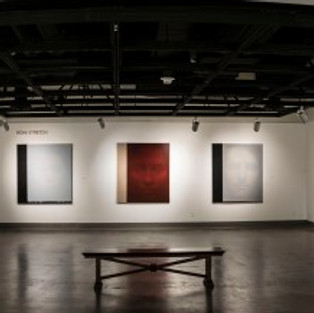Kellogg University Art Gallery at Cal Poly Pomona Brings us “About Face”
- artandcakela
- Apr 15, 2017
- 5 min read

About Face. Kellogg University Art Gallery. Photo Courtesy of the Gallery.
Kellogg University Art Gallery at Cal Poly Pomona Brings us “About Face”
By Nancy Kay Turner
Through April 27th
“The face is only the serial number of a specimen.” ~Milo Kundera
The human fascination with the face has been thoroughly documented in art history, with the oldest, highly abstracted portrait drawn on the wall of the Villonneur Grotto in France and dated to some 27,000 years ago. Since then (until the ascendency of photography in the 20th century), it is painters and sculptors who have supplied the portraits of powerful rulers, as well as historical, mythical, folkloric, religious and imaginary figures. Nothing is more personal than one’s face, which is central to our identity as humans. Our language is filled with expressions like the aggressive “in your face,” the shameful “to lose face” and to make an “about face” as an abrupt abdication of a previously held attitude or opinion.

About Face. Kellogg University Art Gallery. Photo Courtesy of the Gallery.
The exhibit entitled “About Face” (Kellogg University Art Gallery at Cal Poly, Pomona) brings together four consummate painters – Justin Bower, Rebecca Campbell, Salomon Huerta and Roni Stretch, whose diverse work examines identity, status, celebrity, privacy and even mechanization. Justin Bower’s monumental “Moment Of Collision” (2013, oil on canvas) is a larger than life portrait of a digitally deconstructed female cyborg-like “person” (a sci-fi replicant?) looking straight at us. Her seeming perfection starts to shift, slide and blur as if the program designing her is having a nervous breakdown. Breathtaking in scale and showcasing the sheer virtuosity of Bower’s paint handling, it is almost a master class of twentieth and twenty first century painting styles. The hard-edged green stripes of the background echo the 1960’s, with the photorealistic eyes of the 1970’s art movement coupled with the Abstract-expressionist slashing brushstrokes hovering over the mouth and nose area. The multi-colored squeegeed abstract rectangles scattered about remind us of Gerhard Richter’s work. Conceptually cool, unemotional and almost formulaic, the paintings are all variations on the same theme, though each alone is spectacular. However, “Reconstructor” (2017, oil on canvas) is clearly a new and welcome direction for Bowers. There is still the frontal figure in the center of the canvas but with a mutating male face (shades of Francis Bacon) atop a splintering of female torsos (I count 5 breasts) and even a suggestion of a hand on a black leather chair. The background is composed of violent red and black brushstrokes looking more like street art than a digital rendering. Compared to the other, slicker works, this one feels spontaneous and also pleasingly unfinished, as if this newest exploration is in its nascent stage.
While Bowers is “Medium Cool,” to borrow a phrase from Marshall McLuhan, Salomon Huerta’s Boxer series is the polar opposite of Bowers in every way: hot tempered, emotional, spontaneous and intimate in scale. Huerta’s paintings are paeans to the sport of boxing and its celebrities and unsung heroes. Surprisingly tender, the watercolor portraits make the viewer rethink the nature of the boxer himself. In “Leon Spinks (2016, watercolor on paper), the young African-American is shown as an ordinary man — indistinguishable from any other young man his age. His expression is almost neutral, perhaps tired or guarded or even wary. Beautifully painted with a minimum of strokes and muted color, this portrait is as much about the boxer looking at us as it is about us looking at him. Then there are the small oil paintings of close-us of bloodied boxers grimacing faces. The strongest of this series is “Nate Diaz” (2016, oil on canvas). This boxer has bloodshot eyes, mouth agape and strangely elegant, shiny bright blood red strokes swirling around his face (not unlike the Maori face tattoos). Huerta has said “My aim…is to create beautiful portraits so that someone who doesn’t like blood will still tolerate viewing them,” and in this series he succeeds.
In the same room are the ghostly portraits by Roni Stretch. Beautifully crafted and painted, these are for contemplation as the image only appears upon prolonged examination. “Julia” (2013, titanium white and sap green/burlap on canvas) looks like a mash up of Barnett Newman’s “Stations of the Cross,” series, with a black vertical burlap strip affixed to the canvas. Next to it is silky white square with a barely discernable photorealistic large –scale portrait (essentially the eyes/nose/mouth). Stretch allows the drips of the under painting to remain on the bottom strip of the paintings as if to reaffirm that they are indeed paintings not photographs. All the portraits follow the same structure. While they are really accurate portraits of the subjects (who are all really attractive young people), the veil of paint obscures them and they become strangely muted and mute.

Rebecca Campbell Lady Godiva, 2011 oil on canvas 96 x 72″ © Rebecca Campbell 2011. Image courtesy of L.A. Louver Venice, CA. About Face. Kellogg University Art Gallery.
Rebecca Campbell’s prodigious art practice encompasses portraits, allegorical paintings, and installations. As a feminist, she is concerned with cultural identity, feminine notions of beauty and the difficulties of being a woman, mother and artist in this society. Rebecca Campbell has said “I’m painting the portrait of every woman artist I know. I’m painting them so that they will not disappear”. With “Fool, Seer, MFA GRAD (Kyla)” (2011, oil on canvas), Campbell gives us a perplexing portrait of a very pretty co-ed, presumably a very serious artist, with Walter Keane’s (or as we now know — Mrs. Walter Keane’s) kewpie doll eyes ringed with false eyelashes and a supremely worried expression. Her chest area is an indistinct series of tumultuous brushstrokes hinting at an inner disequilibrium. This is ultimately a complex portrait, seemingly exposing the weaknesses and strengths of this particular woman who seems to be representative of so many others with equally fragile egos. Then there is the wonderfully spooky “Diamond Valley” (2011, oil on canvas). A perhaps drug addled (valium, anybody?) housewife, smiling vacantly while absent-mindedly cutting perilously close to her blood red fingers, is situated in front of a window with a rainbow. Campbell’s trademark juicy, almost pastel-hued colors belie the zombie, Stepford-wife sensibility of this image. We will never know and can only imagine what this woman is ruminating on. The only thing we know is that it is not dinner. However, this thoughtful show does give the viewer a lot to chew on and ponder about the face, the nature of portraits, the gaze of the viewer and the role of the artist as seer, observer, commentator and scribe.
#california #losangelesartist #art #painting #JustinBower #onlineartmagazine #losangelesart #contemporaryart #portraiture #southerncalifornia #LosAngelesArtists #AboutFace #artandcake #artexhibition #SalomonHuerta #ArtandCakeLA #NancyKayTurner #fineart #artists #artist #artsmagazine #arts #artreview #RoniStretch #artexhibit #RebeccaCampbell #contemporarypainting #ArtandCulture #exhibition #figurative #exhibit #KelloggUniversityArtGallery







































